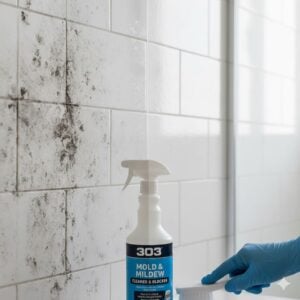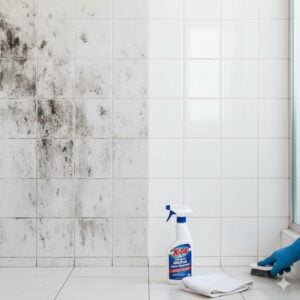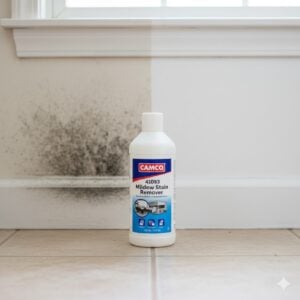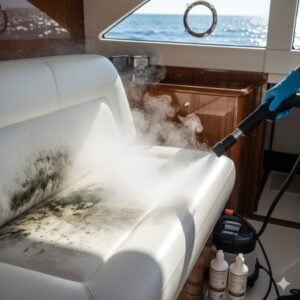When mildew starts appearing on walls, tiles, or furniture, the first instinct is often to grab a bottle of mildew remover spray from the nearest store. These products promise instant results, but not all sprays are equal — and not every surface can safely handle chemical cleaners. In the UAE’s humid climate, where mold and mildew develop quickly, understanding the right removal methods, their costs, and risks is essential. Here, we’ll explore nine DIY options, when they work, when they don’t, and how professional treatments like Bio-On UAE provide safer, long-lasting results.
Table of Contents
ToggleUnderstanding Mildew and Why It Appears
Mildew is a surface-level fungus that thrives in moisture, often showing as gray or white patches on walls, ceilings, fabric, and tiles. In places like bathrooms, kitchens, and air-conditioned apartments, condensation and poor ventilation accelerate growth. Left untreated, mildew damages surfaces, causes odors, and can trigger allergies or respiratory irritation.
DIY Mildew Remover Spray Options
DIY mildew sprays are popular because they’re cheap and easy to make at home. However, results vary based on the type of mildew and the surface affected. Here are nine common DIY options and how they compare:
1. White Vinegar Solution
Mix one part vinegar with one part water in a spray bottle. Vinegar is mildly acidic and kills many mildew species. It works well for tiles, glass, and metal but can damage natural stone like marble or granite. Always rinse thoroughly to remove residue.
2. Baking Soda and Water Paste
A paste made of baking soda and water gently scrubs mildew from grout or walls. It’s non-toxic and safe for most surfaces, but it may not fully kill spores embedded in porous materials like wood or drywall.
3. Hydrogen Peroxide (3%)
Hydrogen peroxide is a strong disinfectant that eliminates mildew without producing toxic fumes. Spray directly onto the affected area, let sit for 10 minutes, then wipe clean. Avoid using it on delicate fabrics or painted walls as it may bleach color.
4. Lemon Juice Spray
Lemon juice contains citric acid, which naturally fights mildew. Combine lemon juice and water in a 1:1 ratio. It’s great for kitchen areas where harsh chemicals aren’t desired, but its effects are temporary and mostly cosmetic.
5. Essential Oil Blend
Tea tree oil or eucalyptus oil mixed with water works as a natural antifungal solution. Add 10 drops of essential oil to a cup of water in a spray bottle. It smells pleasant and discourages future growth but doesn’t clean existing mildew stains deeply.
6. Ammonia Solution
Ammonia removes tough stains on non-porous surfaces like bathroom tiles. However, it releases strong fumes and is dangerous when mixed with bleach. Proper ventilation and gloves are essential when using this solution.
7. Chlorine Bleach Spray
Bleach is one of the most powerful DIY mildew removers. It disinfects quickly but can discolor grout, fabrics, and paint. It’s also harmful to breathe and requires protective equipment. Use only for severe mildew cases and rinse thoroughly afterward.
8. Salt and Vinegar Mix
Mix equal parts salt and vinegar for a mild abrasive cleaner. This works for mild surface mildew but may leave residue if not rinsed properly. Ideal for quick bathroom clean-ups but not for deeper contamination.
9. Alcohol-Based Cleaner
Isopropyl alcohol diluted with water helps sanitize small mildew patches, especially on electronic casings or non-porous furniture. However, it evaporates fast and doesn’t treat root spores, making it a temporary fix.
Risks of DIY Mildew Remover Sprays
While DIY cleaning seems convenient, improper mixtures can lead to health hazards and surface damage:
- Corrosion and discoloration: Acidic or alkaline cleaners can strip paint and erode tiles.
- Toxic fumes: Combining bleach with vinegar or ammonia releases harmful gases.
- Incomplete removal: DIY methods kill surface mildew but not spores beneath the surface.
- Health risks: Mold spores released during scrubbing can cause coughing, allergies, and headaches.
- Short-term effect: Without root removal, mildew reappears in days or weeks.
DIY methods are best for small areas or preventive maintenance. For larger infestations or porous materials like fabric, drywall, or wood, professional cleaning is necessary.
Professional Mildew Removal by Bio-On UAE
Bio-On UAE offers specialized mildew and mold removal services across Dubai, Abu Dhabi, and Sharjah. Unlike DIY sprays, Bio-On uses professional-grade disinfectants, controlled drying, and surface restoration techniques. Their approach eliminates both visible mildew and hidden spores within walls or flooring.
The process includes:
- Surface and air moisture inspection
- Containment to prevent spore spread
- Application of anti-fungal and anti-bacterial treatment
- Steam extraction and HEPA filtration to sanitize the area
- Final deodorization and preventive coating
What makes Bio-On unique is its integration of European safety standards and eco-safe methods approved by UAE municipalities. This ensures your space not only looks clean but remains hygienically safe long after treatment.
Comparing DIY vs Expert Mildew Removal
| Aspect | DIY Mildew Remover Spray | Bio-On UAE Expert Treatment |
|---|---|---|
| Effectiveness | Removes visible mildew temporarily | Eliminates spores and prevents regrowth |
| Safety | Risk of harmful fumes and surface damage | Eco-friendly, safe for people and pets |
| Longevity | Lasts days to weeks | Lasts months to years with preventive coating |
| Cost | Low upfront cost (AED 10–30 for ingredients) | Professional service starting from AED 20–40 per sq.m. |
| Time required | DIY takes hours with manual scrubbing | Professional cleaning completed in a few hours |
Cost of Expert Mildew Removal in UAE
Pricing depends on the area size and severity of mildew:
- Small patches (up to 3 sq.m): AED 100–150
- Moderate mildew (4–7 sq.m): AED 200–300
- Severe cases (8–10 sq.m): AED 400–600
- Large or recurring infestations: Free inspection and customized quote
Disclaimer: Prices vary by surface type and accessibility. Bio-On UAE always confirms cost after inspection.
Benefits of Choosing Professionals Over DIY
- Guaranteed long-term mildew prevention
- Use of safe, non-toxic materials suitable for homes and offices
- Reduced health risks from spore exposure
- Certified technicians trained for high-humidity environments
- Odor elimination and indoor air improvement
Bio-On’s team also provides recommendations to prevent recurrence, such as improving ventilation or installing dehumidifiers in prone areas.
How to Prevent Mildew After Cleaning
- Ensure proper ventilation in bathrooms and kitchens
- Wipe down wet surfaces immediately after use
- Fix leaks promptly to avoid hidden dampness
- Use anti-mildew paint or sealants in humid areas
- Schedule professional inspection twice a year
Conclusion
Mildew remover spray can be useful for quick fixes, but DIY methods come with limitations and risks, especially in humid UAE environments. While vinegar or hydrogen peroxide may handle surface stains, they rarely address the deeper spores that cause recurring mildew. For complete, long-lasting results, Bio-On UAE provides professional cleaning and disinfection tailored to your space. Their eco-friendly process ensures safety, freshness, and protection from future growth. If your home or office struggles with persistent mildew, the smartest solution isn’t another DIY mix — it’s expert care that guarantees lasting cleanliness and peace of mind.













